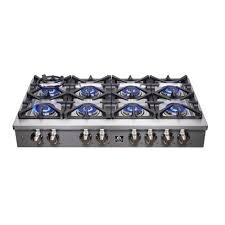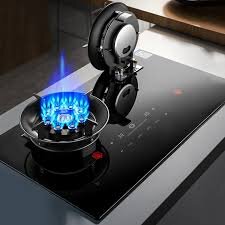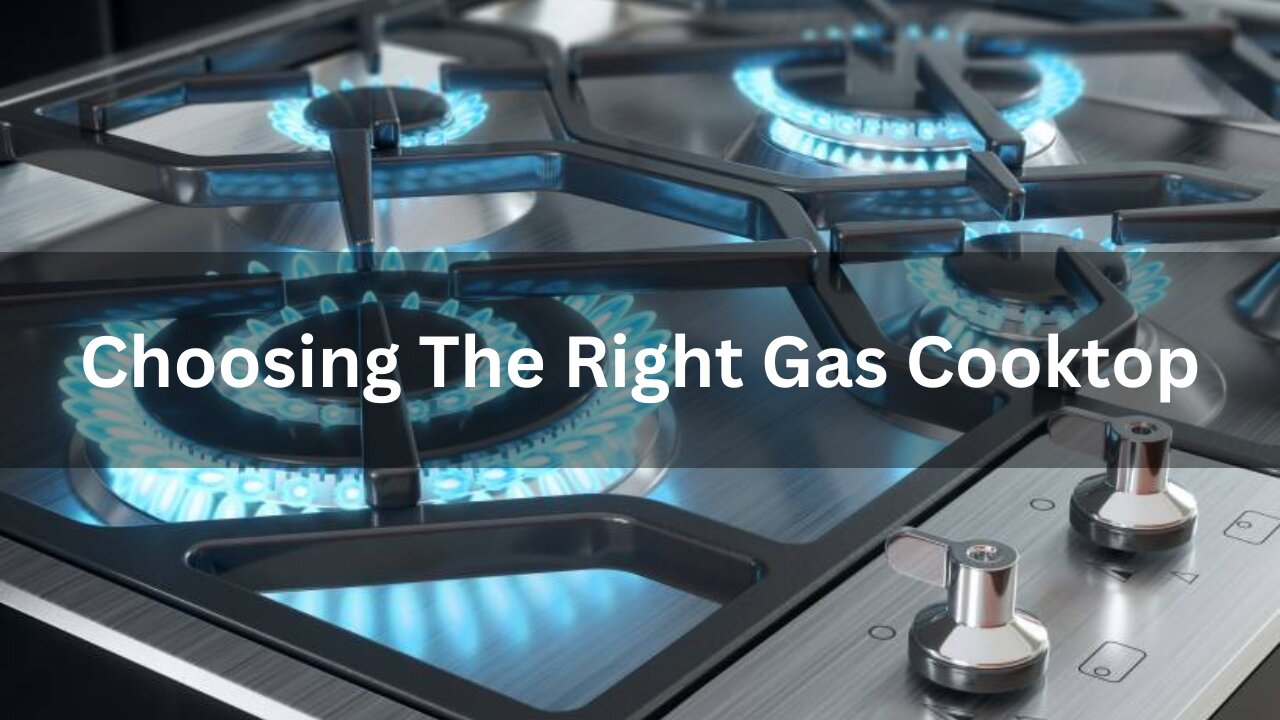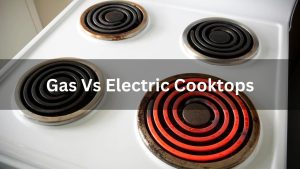To choose a right gas cooktop for your kitchen, firstly, you should take an overview of your kitchen to understand the layout and space for your cooktop. Then, you can choose the right size for your cooktop. There are many steps to understand before buying an induction cooktop.
The first thing is to know more about the kitchen layout, space, and fuel source than the steps to see features of the gas cooktop, such as ventilation types, griddle types, and the activation of the stainless steel touch control. After seeing the features, you have one more step to choose how many burners you need.
Table of Contents
How does a gas cooktop work?
Gas cooktops combine gas with air, igniting the mixture with a spark. The size of the flame is determined by the amount of gas released, which is controlled by the knob.
Types of Gas Cooktops
Gas cooktops come in several designs:
- Slide-in Cooktops: These integrate into countertops for a seamless look.
- Drop-in Cooktops: Fitted into custom-cut sections, they provide a minimalist finish.
- Freestanding Cooktops: Portable options ideal for small or modular kitchens.
What should I look for when buying a Gas cooktop?
The first step to buying a new cooktop is to look at your kitchen setting and available space to determine the cooktop size you need. Before buying a right gas cooktop, check the electric and gas connections in your kitchen and choose an appropriate cooktop that can easily adjust in your kitchen. Moreover, You need to think about the features that can enhance your creative cooking process, which are discussed below;
- Kitchen Layout
Standard cooktop sizes range from 15 to 36 inches wide, but your size may depend on the countertop dimensions, the location of other appliances, and the space you prefer in your kitchen.

Existing gas or electrical connections may also influence your decision-making process. If your kitchen already has a gas hookup, you can choose between gas and electric cooktops.
If you have no gas connection, install it for any gas cooktop.
- Cooktop Fuel types
Be careful; before buying a cooktop, check your kitchen’s existing connections. Gas cooktops use burners and an open flame for cooking, whereas electric cooktops use electric metal coils or other heating conductors. Moreover, gas cooktops tend to offer a more hands-on experience by offering quick flame and heating adjustment.
Electric and induction cooktops provide direct energy to the bottom of your cookware for fast boiling and offer a stable surface that is easy to clean after cooking.
- Cooktop dimension
A standard cooktop is normally 30 inches wide and includes four burners. However, commercial-style cooktops can be 15 to 36 inches wide to fit in both small and large kitchens. They can even be 48 inches or more.
- Cooktop burner Configurations
Various cooktop sizes and burner configurations are available to suit your cooking style. A 15-inch, two-burner electric cooktop provides space-saving features for smaller spaces. A 36-inch, five-burner gas or electric cooktop may be ideal for those needing more cooking area.

Moreover, commercial-type cooktops with six burners are also available for professional-level cooking at home. A standard 30-inch cooktop with four burners offers ample room and more flexibility for most kitchens.
- Cooktop ventilation
Proper cooktop ventilation clears the air and reduces the remaining odors in your kitchen. When choosing the cooktop, you need to look at flexible ventilation options, which include range hoods and downdraft systems.
Downdraft cooktops merge the ventilation system directly into the cooktop, eliminating the need for overhead vents or a range hood. This is ideal for open-floor pans, which provide more cooking space and allow you to enjoy a clean kitchen environment.
- Cooktop heat type
As you know, radiant and induction cooktops have flat surfaces but differ in heating sources. Radiant cooktops use heating elements below the surface, while induction cooktops use electromagnetic waves to heat the cookware directly, Which keeps the surface cool unless compatible cookware is present.
Moreover, an Induction cooktop requires pots and pans with magnetic disks, like cast iron and enameled steel, and doesn’t work with ceramic, glass, copper, or aluminum cookware.
- Price
Gas, electric, and induction cooktops offer diverse features and burner configurations to suit various cooking needs. Prices fluctuate based on these factors.
- stainless steel
Stainless steel cooktops provide a timeless, modern look that effortlessly blends with any kitchen design. Their durable construction ensures long-lasting performance.
- Touch activated control
Seamlessly integrated touch controls offer intuitive operation and accurate temperature settings, exemplified by the KitchenAid induction cooktop.

- Griddle
Expand your culinary horizons with a right gas cooktop equipped with a removable grill. You can cook on any part of the surface, from perfect pancakes to sizzling quesadillas.
- Dual And triple elements
Enjoy greater cooking versatility with electric cooktops featuring adjustable surface elements that accommodate different pot and pan sizes, allowing for personalized cooking experiences.
12. Ignition Types
Two main ignition types are available:
- Electric Ignition: Convenient and efficient; requires a power source.
- Manual Ignition: Useful in power outages, but takes practice to use safely.
13. Brand Reliability and Warranty
Choose a brand known for durability and customer support. Look into warranties and reviews for insight into product longevity and service.
What is the difference between cheap and expensive gas cooktops?
The price difference between cheap and expensive gas cooktops primarily stems from several key factors:
Build Quality and Materials
- Expensive cooktops: Often made from high-quality stainless steel or cast iron, ensuring durability and a premium look.
- Cheap cooktops may use lower-grade materials, potentially affecting longevity and appearance.
Burner Design and Performance
- Expensive cooktops: Typically feature advanced burner designs, offering precise flame control, higher heat output, and even heat distribution.
- Cheap cooktops Might have simpler burner designs, potentially resulting in less control and uneven heating.
Features and Technology
- Expensive cooktops: Often include additional features like simmer burners, wok burners, electronic ignition, and safety features like automatic shutoff.
- Cheap cooktops may need these features, but they offer a more basic cooking experience.
Brand Reputation and Warranty
- Expensive cooktops Often come from well-established brands with a reputation for quality and offer more extended warranties.
- Cheap cooktops: These may be from lesser-known brands with shorter warranties.
Aesthetics and Design
- Expensive cooktops: Typically boast modern designs and finishes, complementing high-end kitchen aesthetics.
- Cheap cooktops May have simpler designs and less premium finishes.
While a cheaper gas cooktop might suffice for basic cooking needs, an expensive one often provides superior performance, durability, features, and aesthetics.
Best Gas Cooktop Brands
Choosing a right gas cooktop involves considering budget, features, and design. Here are some of the top-rated brands known for their quality and performance:
High-End Brands
- Thermador: Renowned for professional-grade performance and innovative features.
- Wolf: Offers luxurious designs and top-tier cooking technology.
- Sub-Zero Wolf: Combines the best of both worlds with high-end refrigeration and cooking appliances.
- Miele: Known for precision engineering and long-lasting durability.
Mid-Range Brands
- Bosch: Provides a balance of quality, features, and price.
- KitchenAid: Offers stylish designs and reliable performance.
- GE Cafe: Blends modern aesthetics with practical features.
- Samsung: Combines technology with cooking performance.
Budget-Friendly Brands
- Frigidaire: Provides affordable options without compromising basic functionality.
- Whirlpool: Offers a wide range of models to suit different needs.
Important Considerations:
- Burner configuration: Choose the number and placement of burners based on your cooking habits.
- Grates: Cast iron grates are generally preferred for durability and heat distribution.
- Ignition system: Electronic ignition is often more convenient than manual ignition.
- Safety features: Look for options like automatic shutoff and flame failure detection.
Remember to read reviews and compare features before making a final decision.
Conclusion
Selecting the right gas cooktop hinges on carefully assessing your kitchen’s layout, available space, and personal cooking style. Factors such as fuel type, cooktop size, burner configuration, ventilation, and heat type significantly influence decision-making. While gas cooktops offer precise heat control and a traditional cooking experience, electric and induction options provide alternative benefits like easy cleaning and efficient energy use.
Prioritize safety features, consider your budget, and explore various brands to find the perfect match. By carefully weighing these factors, you can confidently choose a right gas cooktop that enhances your kitchen’s functionality and elevates your culinary endeavors. Remember, investing in a high-quality cooktop improves your cooking experience and adds value to your home.
FAQs
How many burners do I need for my kitchen?
For a single person or couple, 2-3 burners are often sufficient. Families may need 4-6 burners.
What is the best material for a gas cooktop?
Stainless steel is durable and easy to maintain, while glass offers a sleek look but requires more care.
Is a high BTU always better for cooking?
Not necessarily. High BTUs are ideal for fast cooking, but precise, lower BTUs work better for slow cooking and simmering.
Are gas cooktops safe?
Yes, especially with flame failure protection and automatic shut-off features to prevent accidents.
Can I install a gas cooktop myself?
Installation should be done by a professional to ensure safe gas connections and adherence to local regulations.




